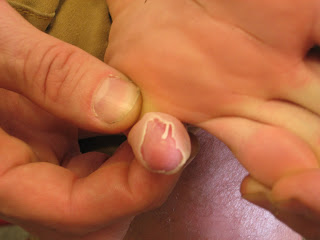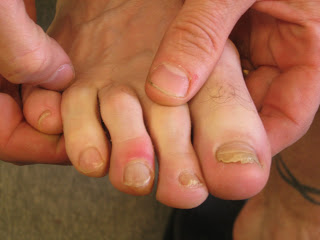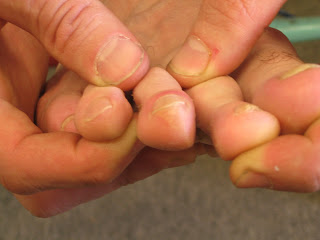I’ll let you in on a little secret. Running 100 miles is not that hard. For most races you get at least 30 hours to do it. You only have to run a little over 4 miles per hour to break 24 hours. Almost anybody who has a strong will and puts in a decent amount of training can do it. Really. Of course your legs get sore. Of course you get really tired. The real secret to doing it is to quickly manage the little things that can turn into big things as the time wears on.
I love running 100 mile races. But my biggest fear going into any race is blisters. It’s actually why I’m so neurotic about running shoes. My fantasy is to be able to run 100 miles without getting any blisters. As I’ve become more experienced I’ve learned tricks to minimize them, which I would like to share in this post. I’ve yet to eliminate them, but I’m going to keep trying.
For years (and still now) I have been chasing the perfect shoe. One that holds my foot perfectly so that my toes don’t jam against the front (and blister) on long downhills. Ones that don’t have seams on the inside that cause blisters. Ones that drain quickly (so I don’t blister). Ones that have a soft heel cup (so I don’t blister). Ones that don’t get to hot, so my feet don’t sweat to much so, you guessed it, I don’t blister.
The problem is that a shoe that feels great for a few hours might feel totally different after 6. And at 6 hours, I still have at least 14 more to go. The type of course your on will have an impact too. A shoe that is great for singletrack might end up being terrible for a wet rocky course with lots of lateral movement.
The two types of blisters that I usually run into are on my pinky toes and under the nailbed. When I get them on my pinky toes, they look like somebody injected air into the skin and the entire layer of skin seperates. When it bursts it is phenomenally painful. Here is a picture of the aftermath.
And here are some pictures of a blister under the nail cuticle. This type of blister all but guarantees that I will lose the toenail in the near future as the pressure separates it from the nail bed.
Other types of common blisters include severely macerated (waterlogged or “swampfoot”)
 |
| Famous picture of Andy Jones Wilkins |
And bad heel blisters:
 |
| Severe Heel blister on New England Ultra Runner Michelle Roy |
Some runners I know are just plain tough. They manage to have the mental strength to just run through these types of blisters. I’m just not that tough. So the quest continues. Here is what I have learned so far to minimize the damage. I hope that some of my suggestions may spare somebody some pain in the future.
Rule #1. Keep your feet as dry as possible. In most ultras you have to run through streams and or snow. Pack spare socks and dry your feet as often as you can.


















Speak Your Mind